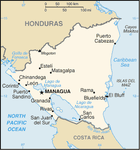Browse All Nicaraguan Recipes: Nicaraguan Appetizers | Nicaraguan Beverages | Nicaraguan Soups | Nicaraguan Salads | Nicaraguan Vegetarian | Nicaraguan Meat Dishes | Nicaraguan Snacks | Nicaraguan Desserts

|
This article is a stub! This article doesn't contain enough information. If you know anything about Nicaraguan Cuisine, please add to this article!
|
Nicaragua - Cooking and Food[]
Overview of Nicaraguan Cuisine History[]
Nicaragua is the widest state situated in Central America, which has a territory full of mountains and active volcanoes, but also lakes and fields with agricultural products. The most common aliments that are produced by the intern agriculture are the coffee, sugar cane and lemon trees, but cattle breeding is also very common.
Due to the fact that Nicaragua is a Latin American country, its cuisine is very representative for the Latin culinary culture, as it includes Argentinean and Mexican dishes, but also some that can be found in El Salvador or Costa Rica, which are Nicaragua’s neighbors. All sorts of colored beans, beef dishes, chimichurri sauce, cabbage, tomatoes, rice, chicken dishes and milk based desserts are the most representative for the Nicaraguan cuisine. Within the Nicaraguan cuisine, the combination possibilities and mixtures between animal and vegetarian products is unlimited, especially due to the various spices and preparation techniques used by the Nicaraguan people in their traditional meals. This is a wonderful dish for the holidays.
Cuisines of Nicaragua[]

Map of Nicaragua- Click to enlarge
There are some culinary differences in Nicaragua between the rural and the urban areas. In the capital of Managua, the selection of foods is much wider and there are various international restaurants that provide food from all the continents, including specialized menus with low calories, Spanish cuisine and French food or seafood specialties. In the villages, the options are more limited regarding the international ..., but there are more traditional dishes, like nactamal (with corn meal, milk, lard, potatoes, green peppers, onions and garlic), vigoron (similar to a fast food dish with pickled cabbage), vaho (a mixture of meat, plantains and yuca), gallo pinto (beans and rice), sopa pinto, sopa mondongo (tripe soup with various veggies), pescado topitapa, brochetas (a salsa with Sugar, tomatoes, lemon, vinegar, oil and fish) and tres leches cake (made of flour, unsalted butter, Sugar, eggs, vanilla, milk, sweetened and condensed milk and evaporated milk, plus whipping cream and vanilla).
Nicaraguan Food Glossary[]
Finding the ingredients for an Nicaraguan Recipe is not so easy when you do not know the names of the ingredients. Take time to make a list of ingredients and the name they may be found under at the Local Markets.
- Check out the Nicaraguan Food Glossary
Preparation Methods for Nicaraguan Cooking[]
Nicaraguan cuisine uses elements from various cooking traditions borrowed from their neighbors and developed from their own traditional dishes. While there are no specific or unique preparation methods for Nicaraguan cooking, we should point out that attention to detail is important in the Nicaraguan cuisine. Using the right amount of spices for example is essential – either for spicing up the taste or for coloring the dish. The diversity of vegetables and cereals found in Nicaragua is also noticed in the delicious dishes belonging to their cuisine. The visual attractiveness of the dish is also important, and a balance between colors and proportion differentiates. Each traditional dish has a special cooking method, which is more or less general in all of Nicaragua’s regions. Meat is one of the main elements of most Nicaraguan dishes and cured and smoked hams are often parts of delicious dishes. Many of Nicaragua's specific spices can still be found here.
Special Equipment for Nicaraguan Cooking[]
Ranging from cake pans, can openers, colanders, egg rings, poachers and holders, food dishers & portioners, food pans & food containers to other kitchen utensils, such as food scales, food scoops and fryer baskets & accessories, the Nicaraguan cuisine needs a diverse cooking equipment set in order to produce the most sophisticated Nicaraguan dishes. You should consider insulated food carriers if you are transporting the food and a full set of kitchen linens and uniforms if you wish to look like a pro. Here are a few other items that will come handy while cooking Nicaraguan food: juicers, kitchen knives, kitchen slicers, kitchen thermometers, measuring cups & measuring spoons, miscellaneous utensils, mixing bowls and skimmers & strainers. Essential utensils like serving spoons, spatulas, forks, turners, scrapers and tongs should also be part of your cooking "arsenal".
Nicaraguan Food Traditions and Festivals[]
An interesting fact regarding the Nicaraguan festivals and celebrations is that besides the general and public holidays, there are many cities which celebrate independent festivals. Nicaragua even has a special day entitled Fiesta Day (Party Day), celebrated on the 1st of August. Christmas is a very important holiday and people in Nicaragua love to celebrate it with large family feasts. The Christmas menu includes rich meals, such as roasted Chicken, various salads and complex garnishes of potatoes, tomatoes and cabbage and the pio quinto cake with rum. On Christmas, the streets and churches are decorated and people can buy traditional foods in the streets, among gifts, toys and flowers.
People in Nicaraguan Food[]
- Are you into Nicaraguan Cooking and would like to be interviewed?
There are many chefs who creatively use the basic ingredients and cooking method for traditional Nicaraguan dishes and create original and delicious food variations. Nicaraguan chefs are passionate about their traditional dishes and they enjoy presenting them to foreigners who have never tasted them before. Whether they are cooking dishes that go back in time for centuries or brand new, modern dishes, Nicaraguan chefs take pride in what they do, and this is readily noticeable in the unforgettable taste of their cooking.
